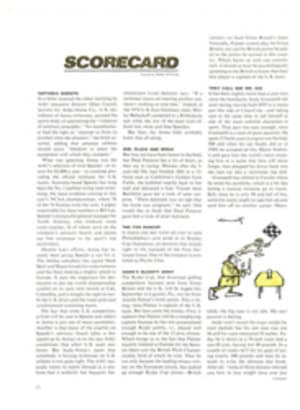
IT WAS A FOREIGN AFFAIR
Thanks to a bunch of guys who wouldn't know Sam Houston from Sam Spade, Lady Bird from Big Bird or the Alamo from a Pizza Hut, the team championship of U.S. collegiate track and field now resides in the proud state of Texas.
No 10-gallon ovations need hail this acquisition, since not one Texan—or many Americans—contributed to the University of Texas-El Paso's victory last week in the 54th NCAA championship meet at Provo, Utah. On the teal-blue track of Brigham Young Stadium, foreign athletes stole most of the show and made their rivals break out in flags.
UTEP, for which passports have long been as important as spiked shoes, added its first outdoor title to the NCAA indoor championship it won in March by scoring 55 points during the five-day competition. Eighty percent of the Miners' total was amassed by athletes from Sweden, Kenya and Australia. Combined with the forces of nature and negligence, the Texas aliens were more than enough to hold off a domestic entry named UCLA, which scored 42 points to finish second. USC, almost everyone's pre-meet favorite, paid dearly for its youth and came in third with 37 points.
The fall of Troy resulted in the championships ending with the Bruins grouped on the field waving tiny American flags. It was their way of indicating that, while they might have finished second to UTEP, among their countrymen they were first.
Moments before the Miners' victory became official, UCLA Coach Jim Bush said, "I feel this way. Going against all the foreigners on UTEP's team with all the bad breaks we had and still getting second is one heckuva job. We're going to lay claim to the title of No. 1 American team. That's the only way I can make people realize how the foreigners are dominating this meet."
Non-Americans did not totally dominate the meet, but they accounted for eight of the 19 individual titles and three of four meet records. John Ngeno of Washington State, a Kenyan who set stadium marks in winning the three-mile (13:22.79) and six-mile (28:20.66), was the only one of the eleven 1973 champions on hand to successfully defend his crown; he had won the six-mile last year. Villanova's Eamonn Coghlan, an Irishman with a superb finishing kick, won the meet's glamour event when he took the mile in 4:00.06. The most dramatic performance was that of Illinois' Charlton Ehizuelen, a Nigerian who watched Danny Seay of Kansas long-jump to a meet record of 26'7¾" and five minutes later, on his last try, won the event by leaping 26'11".
UTEP's march to the title began with a setback. Greg Joy, a Canadian high jumper with a season best of 7'4", failed in the qualifying round to clear 7'1", the height required to advance to the finals. UCLA got off to an even poorer start. Mike Tully, a freshman pole vaulter who has jumped 17'10", was out of the meet when he missed three times at 16'8", and Jerry Herndon, the 1974 NCAA long-jump champ, finished 31st when he could do no better than 23'1½" in the trials.
The Bruins' luck worsened as the championships progressed. In one of the biggest gaffes in meet history, a semifinal heat of the 120-yard high hurdles was bollixed up, the last row of hurdles being set up almost four yards closer to the finish than it should have been. The hurdlers would not have been more surprised if a chain had replaced the tape. UCLA's Clim Jackson, leaving part of his shin on the last hurdle, stumbled to victory in the heat, but Kansas State's Vance Roland and Colorado's Derek Ligons were not as lucky. Both fell.
The ordering of a rerun generated a heated protest from Bush. He pointed out that with the final scheduled to be run in less than an hour, it was unfair to make Jackson and his rivals from the first semifinal run two preliminary races while the other qualifiers ran only one.
"You can't do that," he said to BYU Coach Clarence Robison, the meet director. "Those guys only have so many races in them a day. If you make them run, make everybody else run, too."
Finally, the decision was made to hold the race the next night. For UCLA, it didn't help. The track was wet and Jackson slipped twice. Larry Shipp of LSU won in 13.91, UCLA freshman James Owens coming in second. Jackson, who had figured to win, finished fifth.
Shortly after the hurdle hassle, UTEP shot into the lead by proving that two Hans are better than one, especially when they finish 1-2 in the shotput. That's exactly what Hans Hoglund, a 6'4", 275-pound Swede, and freshman Hans Almstrom, Hoglund's 6'5", 290-pound countryman, did. Hoglund, a three-time NCAA indoor champ, got a personal best when he opened with a 67'11" heave, then improved that with a meet-record 70'0". Almstrom's first throw (65'8¼") was good for second. Added to the nine points the Miners had scored in the hammer throw, where Aussie Pete Farmer was second, and two points in the six-mile, the shotput double gave UTEP a first-day total of 29.
After the perfect weather on the other four days of the meet, the drenching, chilly rainstorm on Saturday was a shock. The storm was accompanied by lightning bolts and a pernicious wind that delayed the competition 64 minutes and killed whatever long-shot hope UCLA had.
The wind aided the triple jumpers in the first and third flights but blew into the faces of those in the second, including UCLA's Willie Banks, whose 55'1" personal best had beaten USC in their dual meet earlier this year. At Provo he jumped 50'1¼", which was only good enough for 10th place. By causing hurdler Jackson to skid and Banks to stall, the weather effectively doused the Bruins, despite Benny Brown's 45.34 victory in the 440, a stadium record that might have been a world mark without the rain.
Meanwhile, UTEP was adding inexorably to its first-day point total. James Munyala, the Kenyan steeplechaser, moved into the lead after a mile and sprinted to an 8:47.93 victory.
Almost as Munyala was breasting the tape, the Miners' Arnold Grimes—who hails from Akron, oddly enough—caught an aiding 14-mph wind for a 54'2½" triple jump. It moved him into second behind San Jose State's Ron Livers, the winner at 55'1¾". Earlier, UTEP had received six points from Wilson Waigwa's third in the mile. The Miners added two more on Larry Jesse's fifth in the pole vault, an event in which both Earl Bell of Arkansas State and San Jose's Dan Ripley cleared 18'1" for a meet record. Bell won the event on fewer misses.
"We thought we'd have a few more points," said UTEP Coach Ted Banks. "Losing our high jumper kind of discouraged us, but when we took the 1-2 in the shot it gave us impetus. Perhaps we had more solid points than some of the other teams."
A couple of UTEP fans celebrated their title by throwing Banks into the steeplechase water jump, but the rest of the Miners were relatively subdued. In fact, Jesse, the pole vaulter from Dayton, was slightly disappointed.
"We all get along pretty good," he said of his team. "It's nice you can talk to guys from all over the world and stuff, but tonight me and Grimes hoped we'd be the guys who'd win because everyone always writes about UTEP being powered by the Kenyans and stuff. There's a lot of Americans on the team with ability, but they get overshadowed because everybody wants to read that we got Swedes and Kenyans and whatever."
Well, maybe not everybody. Readers in Los Angeles would love to find that the Miners had lowered their import quota. It's no fun sending American boys to fight the foreign legion.
PHOTO
Charlton Ehizuelen of Illinois and Nigeria set a meet record (26'11") on his final jump.

